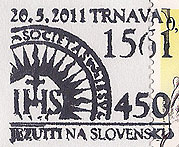
SLOVAKIA, 2011, special cancel to mark 450 years of Jesuit presence in
the area of Slovakia
The Church of the Holy Savior, Bratislava

CZECHOSLOVAKIA, 1988, a stamp featuring an etching of Hlavne Square
circa 1840 by R. Alt-Sandman
the once and future Jesuit Church of the Holy Savior is portrayed to the left
of the old town hall, Scott 2719
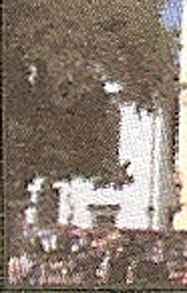
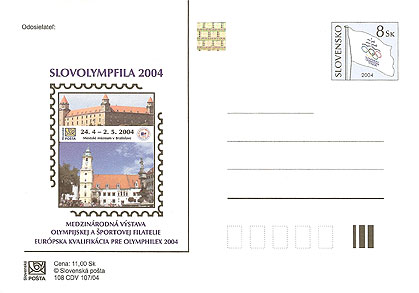
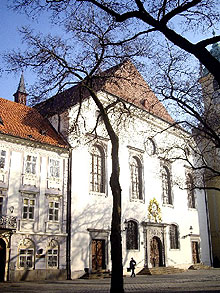
SLOVAKIA, 2004, postal card, issue number 108 CDV 107/04, with detail
of the church to the left, photo to the right
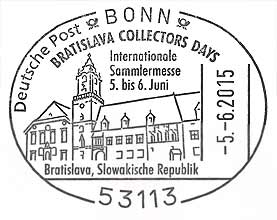
GERMANY, 2015, a cancel for the Bratislava Collectors Days shows the
Jesuit church to the left of the town hall.
The above postal card centers on the old town hall with its tower on Franciscan Square in Bratislava. The building houses the Bratislava City Museum. To the left, under the trees, can be seen part of the Church of the Holy Savior, also called the Jesuit Church (Kostol Najsvätejšieho Spasitela, Jezuitský kostol). This late-renaissance church was built by German evangelists (1636-1638) after being granted an imperial concession to build a place of worship on the condition that it have no tower. It was confiscated from them in 1672 and given to the Jesuits the next year, who to compensate for its external simplicity redecorated the interior in Baroque style. The church includes a beautiful Rococo pulpit by Donner´s pupil Ludovit Gode and altar paintings by Franz Xaver Palka. The church was lost at the Suppression in 1773, but was returned on the 2nd of January 1990 and is once again being tended to by the Society. The building to the left of the church in the photo above is the Collegium Sanctissimi Salvatoris (College of the Most Holy Savior) and behind the church is the Theological Faculty of The University of Trvana.
The Church of Skalka by Trencín
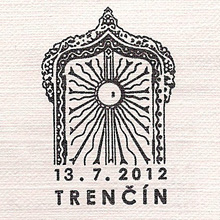

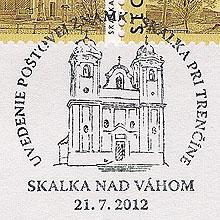
SLOVAKIA, 2012, the Church of Skalska as part of the "Beauties
of Our Homeland" series, Scott 643, and
together with its FDI cancel (left) and special cancels (right) .
This pilgrimage site was founded on the rock on the right bank of the Váh river, north east of Trencín. According to legend, St. Andrew Zorard and his follower St. Benedict Skalka worked here and St. Benedict also died here a martyr’s death. The regional cult of these hermits was officially declared in 1083 when Ss. Svorad and Benedict were canonized as one of the first Hungarian saints. At the end of the 12th century there was a church built in the Romanesque style consecrated to St. Benedict and All Saints on Velká Skalka. The bishop of Nitra, Jacob I founded the Benedictine Abbey here in 1224 and it became the religious center of this part of Považie (territory around Váh river). This monastery was plundered and destroyed many times and in 1528 ceased to exist completely. In 1644 the Jesuits began to administrate the monastery, which they gradually renovated and rebuilt. In 1745 they built a two-tower pilgrimage church in the Baroque style on so-called Malá Skalka, south of the monastery on the raised plateau of limestone rock jutting out into the river. According to the legend, this was on the place where the body of St. Benedict´s was cast into the river. After the Suppression of the Jesuits the property passed to the State, but it continues today as a pilgrimage site.
Holy Trinity Church, Trnava

SLOVAKIA, 1998, showing the town hall tower: to its left the Jesuit
Church of the Holy Trinity
and in front of it a Trinity Column bearing
a statue of Xavier, Scott 221
After the Restoration of the Society, in 1853 the Jesuits were given the Church of the Holy Trinity in Trnava and the attached residence, seen on this stamp to the left of the town tower, for the use as a novitiate. This Baroque single-nave church with its twin towers was built in the years 1720-1729 by the Order of Holy Trinity, who came to Trnava in 1712. When this religious order was abolished by the Emperor Joseph II in 1783, the buildings were first used as a grammar school, and later occupied by the Benedictines. In 1853 it was entrusted to the Jesuits, who rebuilt it in 1875. At one side altar of the church is a glass case with the bodies of, both of whom were martyred with St. Marko Krizevcanin, canon of Esztergom, in Košice in 1619.
The University of Trnava

CZECHOSLOVAKIA, February 6, 1985, the 350th anniversary of the "University
of Trnava," Scott 2546
the first of its many names, to remind the world of where it all began

CZECHOSLOVAKIA, from a black proof of a design that did not make it
into print,
to honor the 350th anniversary of the University of Trnava in 1985.
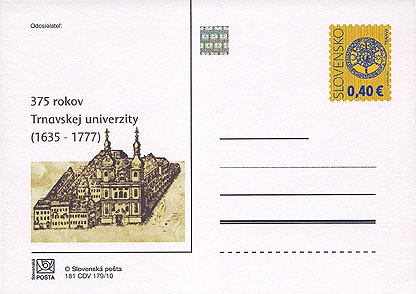
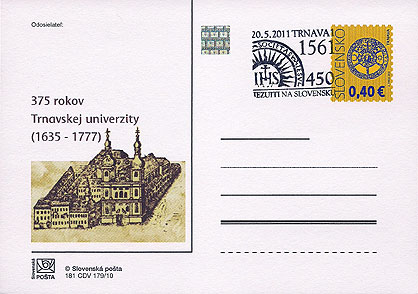
SLOVAKIA, 2010 postal card for the 375th anniversary of the University
of Trnava
and with a cancel for the Jesuits' 450th anniversary
in Slovakia.
Archbishop Nicolas Oláh of Trnava invited the Jesuits to Nagyszombat (now Trnava, Slovakia), as early as 1561 to begin building its educational system. By 1635 Cardinal Peter Pazmany, SJ had founded a Jesuit university there, which Czechoslovakia honors as the University of Trnava. The proof above features the Baroque University Church of St. John the Baptist, which actually dates from 1637, and the university buildings. In 1985 the Czech Communist government was distressed at the growing interest in religion on the part of young people in Czechoslovakia and blamed the education system, which did not sufficiently stress a scientific-atheistic education. That may be one reason this design did not make it into print. Rather than feature a Jesuit and a church they chose the innocuous design they did. At the Suppression in 1773 the university passed out of Jesuit hands, moved to Budapest and today after various changes of name it is Eötvös Loránd University.